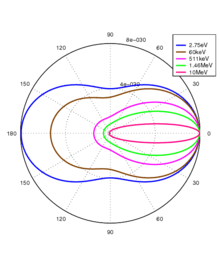Klein–Nishina formula

The Klein–Nishina formula[1] gives the differential cross section of photons scattered from a single free electron in lowest order of quantum electrodynamics. At low frequencies (e.g., visible light) this yields Thomson scattering; at higher frequencies (e.g., x-rays and gamma-rays) this yields Compton scattering.
For an incident photon of energy , the differential cross section is:[2]
where is a differential cross section, is an infinitesimal solid angle element, is the fine structure constant (~1/137.04), is the scattering angle; is the "reduced" Compton wave length of the electron (~0.38616 pm); is the mass of an electron (~511 keV ); and is the ratio of photon energy after and before the collision:
Note that this result may also be expressed in terms of the classical electron radius . While this classical quantity is not particularly relevant in quantum electrodynamics, it is easy to appreciate: in the forward direction (for ~ 0), photons scatter off electrons as if these were about (~2.8179 fm) in linear dimension, and (~ 7.9406x10−30 m2 or 79.406 mb) in size.
The Klein–Nishina formula was derived in 1928 by Oskar Klein and Yoshio Nishina, and was one of the first results obtained from the study of quantum electrodynamics. Consideration of relativistic and quantum mechanical effects allowed development of an accurate equation for the scattering of radiation from a target electron. Before this derivation, the electron cross section had been classically derived by the British physicist and discoverer of the electron, J.J. Thomson. However, scattering experiments showed significant deviations from the results predicted by the Thomson cross section. Further scattering experiments agreed perfectly with the predictions of the Klein–Nishina formula.
Note that if , and the Klein–Nishina formula reduces to the classical Thomson expression.
The final energy of the scattered photon, , depends only on the scattering angle and the original photon energy, and so it can be computed without the use of the Klein–Nishina formula:
See also
References
- ↑ Klein, O; Nishina, Y (1929). "Über die Streuung von Strahlung durch freie Elektronen nach der neuen relativistischen Quantendynamik von Dirac". Z. Phys. 52 (11–12): 853 and 869. Bibcode:1929ZPhy...52..853K. doi:10.1007/BF01366453.
- ↑ Weinberg, Steven (1995). The Quantum Theory of Fields. I. pp. 362–9.
Further reading
- R. D. Evans, The Atomic Nucleus, McGraw-Hill, New York, 1955, pp. 674–676.
- A. C. Melissinos, Experiments in Modern Physics, Academic Press, New York, 1966, pp. 252–265
- O. Klein and Y. Nishina, "On the Scattering of Radiation by Free Electrons According to Dirac's New Relativistic Quantum Dynamics", The Oskar Klein Memorial Lectures, Vol. 2: Lectures by Hans A. Bethe and Alan H. Guth with Translated Reprints by Oskar Klein, Ed. Gösta Ekspong, World Scientific Publishing Co. Pte. Ltd., Singapore, 1994, pp. 113–139.